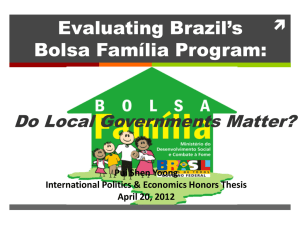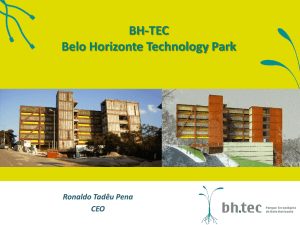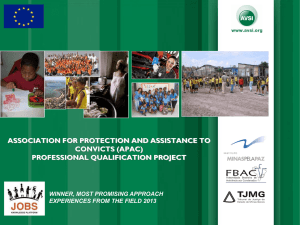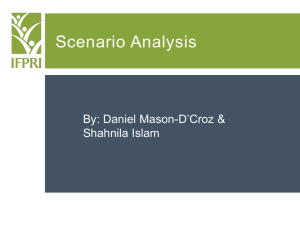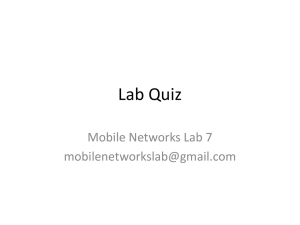Prospective Foresight in Brazil: An overview and cases
advertisement
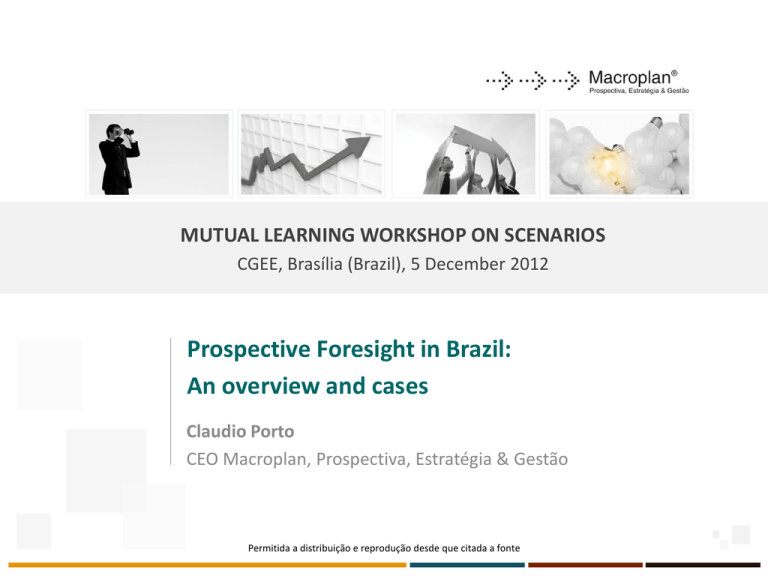
MUTUAL LEARNING WORKSHOP ON SCENARIOS CGEE, Brasília (Brazil), 5 December 2012 Prospective Foresight in Brazil: An overview and cases Claudio Porto CEO Macroplan, Prospectiva, Estratégia & Gestão Permitida a distribuição e reprodução desde que citada a fonte Claudio Porto CEO of Macroplan – Prospectiva, Estratégia & Gestão 30 years working on prospective foresight Macroplan is recognized in the Brazilian marketplace as one of the most experienced consulting Brazilian companies in prospective studies and strategic management Almost 80 prospective studies produced to date Contents The evolution of Prospective Foresight in Brazil Five emblematic cases 1. Scenarios of the Brazilian Economy, BNDES (1984-90) 2. Scenarios about the future of the Amazon Region (ELETRONORTE) (1988, 1998) 3. Introduction and Consolidation of the use of Scenarios in Petrobras (1989, 1992) 4. Scenarios in the State of Minas Gerais (2003-2007) 5. Brazil in transition: current landscape and future trends 2011-2022 (2011) Summary and conclusions The Evolution of Prospective Foresight in Brazil - From the 1970’s to today Until the 1970’s: embryos (IDESP and IUPERJ) 1980’s: emergence (the precursors) 1990’s: dissemination 2000 to today: generalization in large companies or institutions The choice of cases Criteria: the relevance of its impacts, using an elegant application of the idea of the “Greek Triangle” built by Michel Godet (1991) ANTICIPATION (Reason) THE GREEK TRIANGLE APPROPRIATION (Desire) ACTION (Accomplishment) The 1980’s 1980’s - The Brazilian Context 1. External crisis (including the consequences of the oil prices shock in our economy and default of the Brazilian external debt) 2. Low economic growth (“the lost decade”, average 1.55% /year) and social crisis (39% of population in poverty in 1989) 3. Hyperinflation (1,973% in 1989) 4. Economy: closed and technologically outdated 5. Politics: transition from a military regimen to democracy. 1º First Case BNDES economy scenarios (1984) » The National Bank for Economic and Social Development – BNDES is currently the main financial institution for long-term investments in all segments of the Brazilian economy. In 2011 the ampount of it’s disbursements was about US$ 70 billion » 1984: BNDES implemented a strategic planning process that included the use of two macroeconomic scenarios: ADJUSTMENT SCENARIO (THE “OFFICIAL” VISION) • Scrolling annual external debt • Economy: continuity of restrictive policies in accordance with the IMF ECONOMIC GROWTH SCENARIO • Confidencial • External debt renegotiation in the long term and with better conditions • Information leak • Economic policy: resumption of development COMPETITIVE INTEGRATION SCENARIO • Updated industrial structure • Open and competitive economy • External debt renegotiation in the long term and with better conditions • High repercussion in society 1º First Case BNDES economy scenarios (1984) - Impacts ANTICIPATION » The possibility of a new cycle of economic growth APPROPRIATION » By the elected President of the Republic (1989), supported by a strong national desire to overcome recession ACTION AND CONSEQUENCES » Beginning of the openness of the Brazilian economy 2º Second Case (Part one) The scenarios of the Amazon Region and electric energy (Eletronorte, 1988) » ELETRONORTE is a state-owned company that generates and provides electric power to the nine states of the Amazon Region and also provides energy to buyers from other regions of the country. Total installed capacity = 9.294,33 megawatts and transmission systems have over 9.888,02 km of lines. • AMAZON REGION = 49,29% BRAZIL´S TOTAL AREA » Mission: Acting in energy markets in an integrated, cost-effective and sustainable way 2º Second Case (Part one) The scenarios of the Amazon Region and electric energy (Eletronorte, 1988) » Aim: supporting its assessments of demand for electric energy and investment plan. » Three scenarios of Amazon Region from 1989-2010 INTEGRATION WITH THE NATIONAL PROJECT 1 FOCUS ON ENDOGENOUS DEVELOPMENT 2 ECOLOGIC AND CULTURAL RESTRICTION 3 » Two important contributions of this study » introduced the embryo of the sustainable development concept increasing influence in the company’s decisions » Introduced the use of scenarios to prospect the market of electrical energy in Brazil instead of extrapolative forecasts A pioneering initiative that becomes standard in the electrical sector in the 1990’s. The 1990’s 1990’s - The Brazilian Context 1. Stabilization of the economy after the Real Plan in 1994 2. Continuous opening of the Brazilian economy 3. Privatization in several economic sectors, end of monopolies and increased competition 4. Modernization of public institutions (remarkable: regulation) 5. Increased soundness of the financial system 6. Consolidation of democracy 3º Third Case Scenarios of Oil & Gas Industry – (PETROBRAS, 1989, 1992, 1996) » Petrobras is a publicly traded joint-stock corporation whose main shareholder is the Government of Brazil. It acts as an energy company in the following sectors: exploration and production, refinement, marketing and transportation of oil and natural gas, petrochemicals, distribution of oil, electricity, biofuels and other renewable energy sources. The company leads the Brazilian oil sector. » Petrobras Business Plan 2012-2016: investments totaling US$ 236.5 billion (R$ 416,5 billion) - an average of US $ 47,3 billion per year. » Strategic planning was formally adopted by PETROBRAS in 1989 and based on scenario analysis. 3º Third Case Scenarios of Oil & Gas Industry – (PETROBRAS, 1989, 1992) » A participative process » The scenarios and strategic Options in 1992 (Strategic Plan 1992- 2001) PETROBRAS’ SCENARIOS GLOBAL SCENARIOS AND FOCUS ON OIL INDUSTRY 1. Trans-nationalization - hegemony of big private oil companies STRATEGIC OPTIONS • 2. Fragmented Cooperation - shared hegemony in the petroleum industry Consolidation and strengthening in the national market • Expansion of international operations NATIONAL SCENARIOS AND FOCUS ON OIL INDUSTRY • Integration, competitiveness and business excellence • Neoliberal • Permanency of the crisis • Welfare state 3º Third Case Scenarios of Oil & Gas Industry – (PETROBRAS, 1989, 1992) ANTICIPATION » Loss of monopoly and emergence of competition » Increasing uncertainty and new challenges in the industry APPROPRIATION » Assimilation of scenarios and prospective methods by a large portion of the senior management and technical staff of the company ACTION AND CONSEQUENCES » Preparation of the company and its managers and professionals to deal successfully with the end of monopoly, increasing competition and higher uncertainty » PETROBRAS developed a skilled decision making process when faced with uncertainties. Today, the construction of scenarios, which started in the company over 23 years ago, is part of their culture and strategic management process 2º Second Case (Part two) The scenarios of the Amazon Region and electric energy (Eletronorte, 1998) » In 1998, ELETRONORTE decided to revisit the 10 years old prospective study » The prospects of 1989 against the real events of the previous 10 years were evaluated » Four scenarios were devised for the Amazon Region looking into the following 20 years: REGIONAL DEVELOPMENT, MODERATE INTEGRATION AND BETTER QUALITY OF LIFE SUSTAINABLE DEVELOPMENT 1 2 ECONOMIC GROWTH AT 3 THE EXPENSE OF STAGNATION AND POVERTY ENVIRONMENTAL DEGRADATION 3 4 2º Second Case (Part two) The scenarios of the Amazon Region and electric energy (Eletronorte, 1988) - Impacts ANTICIPATION » A systemic view of the main issues and challenges resulting from the economic exploitation of the Amazon Region APPROPRIATON » Relevant contribution to a gradual formation of a political convergence concerning the sustainable development of the Amazon Region. » Recognizing of the potential of economic exploitation of biodiversity ACTION AND CONSEQUENCES » The search for new sustainable production standards for the Amazon Region 2000’s to Today 2000’s to Today – The Brazilian Context 1. Prolonged economic stability 2. Overcoming of external restrictions 3. Increasing social inclusion: “Brazil, a medium class country” 4. Increasing insertion of Brazil into global economy 5. Brazil emerges as an attractive land of economic opportunities 6. New challenges and uncertainties facing the future of the country in the medium and long terms 4º Fourth Case Scenarios and development strategy of the state of Minas Gerais (2003, 2007) • AREA: 586,528 KM² (LARGER THAN FRANCE) • POPULATION: NEARLY 20 MILLION PEOPLE • ECONOMY: THIRD AMONG BRAZILIAN STATES Scenarios for Minas Gerais State 2003-2023 COMPETITIVE TERRITORIAL INTEGRATION Brazil Sustained development of domestic economy Minas Gerais WASTE of opportunities Minas Gerais environment CONQUEST of a better future II I IV III Creative Excluding DECADENCE and impoverishment OVERCOMING adversities EQUITY AND WELFARE INTEGRATED PERSPECTIVE OF THE HUMAN CAPITAL Minas Gerais environment Conservative Inefficient ENVIRONMENTAL SUSTAINABILITY INVESTMENT &BUSINESS NETWORK CITIES Competitive Inclusive STATE FOR RESULTS Domestic economy with intermittent growth “To turn Minas Gerais into the best state to live in” • Strategic Guidelines • Projects 4º Fourth Case Scenarios and development strategy of the state of Minas Gerais (2003, 2007) Scenarios for Minas Gerais State 2003-2023 Brazil • AREA: 586,528 KM² (LARGER THAN FRANCE) Sustained development of domestic economy • POPULATION: NEARLY 20 Minas Gerais MILLION PEOPLE WASTE of opportunities CONQUEST of a better future • ECONOMY: THIRD AMONG Minas Gerais’ BRAZILIAN STATES environment III DECADENCE and impoverishment COMPETITIVE TERRITORIAL INTEGRATION Excluding Brazil Sustained development of domestic economy WASTE of opportunities Minas Gerais IV Minas Gerais environment ENVIRONMENTAL SUSTAINABILITY CONQUEST of a better future II I IV III Creative DECADENCE and impoverishment OVERCOMING adversities EQUITY AND WELFARE INTEGRATED PERSPECTIVE OF THE HUMAN CAPITAL Minas Gerais environment Conservative INVESTMENT &BUSINESS NETWORK CITIES Competitive Inclusive STATE FOR RESULTS Domestic economy with intermittent growth Minas Gerais’ environment Creative Inefficient Excluding I Conservative Scenarios for Minas Gerais State 2003-2023 Inefficient II Competitive OVERCOMING adversities Inclusive • Strategic “To turn Minas Guidelines Gerais into the best stateeconomy to live with in” Domestic intermittent growth • Projects 4º Fourth Case Scenarios and development strategy of the state of Minas Gerais (2003, 2007) COMPETITIVE TERRITORIAL INTEGRATION • AREA: 586,528 KM² (LARGER ENVIRONMENTAL FRANCE) STHAN USTAINABILITY EQUITY AND WELFARE • POPULATION: NEARLY 20 MILLION PEOPLE INTEGRATED PERSPECTIVE OF THE HUMAN CAPITAL • ECONOMY: THIRD AMONG BRAZILIAN STATES INVESTMENT &BUSINESS NETWORK CITIES Scenarios for Minas Gerais State 2003-2023 COMPETITIVE TERRITORIAL INTEGRATION Brazil Sustained development of domestic economy Minas Gerais WASTE of opportunities Minas Gerais environment CONQUEST of a better future II I IV III Creative Excluding DECADENCE and impoverishment OVERCOMING adversities INVESTMENT &BUSINESS NETWORK CITIES Competitive Inclusive STATE FOR RESULTS Domestic economy with intermittent growth “To turn Minas STATE FOR Gerais into the best RESULTS state to live in” EQUITY AND WELFARE INTEGRATED PERSPECTIVE OF THE HUMAN CAPITAL Minas Gerais environment Conservative Inefficient ENVIRONMENTAL SUSTAINABILITY • Strategic Guidelines • Projects 4º Fourth Case Scenarios and development strategy of the state of Minas Gerais (2003, 2007) • AREA: 586,528 KM² (LARGER AFTER DEVELOPMENT OF THE FOUR SCENARIOS, THE FIRST ONE OF THEM WAS THANTHE FRANCE ) • POPULATION 20 CHOSEN AS A: NEARLY REFERENCE FOR THE CREATION OF THE VISION OF THE FUTURE FOR MILLION PEOPLE MINAS GERAIS OVER A PERIOD OF 20 YEARS: • ECONOMY: THIRD AMONG BRAZILIAN STATES “TO TURN MINAS GERAIS INTO THE BEST STATE TO LIVE IN” Scenarios for Minas Gerais State 2003-2023 COMPETITIVE TERRITORIAL INTEGRATION Brazil Sustained development of domestic economy Minas Gerais WASTE of opportunities Minas Gerais environment CONQUEST of a better future II I IV III Creative Excluding DECADENCE and impoverishment OVERCOMING adversities EQUITY AND WELFARE INTEGRATED PERSPECTIVE OF THE HUMAN CAPITAL Minas Gerais environment Conservative Inefficient ENVIRONMENTAL SUSTAINABILITY INVESTMENT &BUSINESS NETWORK CITIES Competitive Inclusive STATE FOR RESULTS Domestic economy with intermittent growth “To turn Minas Gerais into the best state to live in” • Strategic Guidelines • Projects 4º Fourth Case Scenarios and development strategy of the state of Minas Gerais (2003, 2007) THE VISION WAS THEN SPLIT INTO: • AREA: 586,528 KM² (LARGER THAN FRANCE) STRATEGIC GUIDELINES • •POPULATION : NEARLY 20 MILLION PEOPLE • •ECONOMY : THIRD AMONG PORTFOLIO OF STRUCTURING AND LEVERAGING PROJECTS FOR THE BRAZILIAN STATES DEVELOPMENT OF THE STATE Scenarios for Minas Gerais State 2003-2023 COMPETITIVE TERRITORIAL INTEGRATION Brazil Sustained development of domestic economy Minas Gerais WASTE of opportunities Minas Gerais environment CONQUEST of a better future II I IV III Creative Excluding DECADENCE and impoverishment OVERCOMING adversities EQUITY AND WELFARE INTEGRATED PERSPECTIVE OF THE HUMAN CAPITAL Minas Gerais environment Conservative Inefficient ENVIRONMENTAL SUSTAINABILITY INVESTMENT &BUSINESS NETWORK CITIES Competitive Inclusive STATE FOR RESULTS Domestic economy with intermittent growth “To turn Minas Gerais into the best state to live in” • Strategic Guidelines • Projects 4º Fourth Case Scenarios and development strategy of the state of Minas Gerais (2003, 2007) ANTICIPATION » The threat of losing many opportunities unless making severe adjustments in the state and its government APPROPRIATION » Choice of strategies aligned with the scenarios » Realization of the urgent need for modernization of the state government toward higher efficiency ACTION AND CONSEQUENCES » Public policies aligned with the scenarios » “The shock of management” in state government Summary and Conclusions Anticipation Appropriation Action BNDES (1984) ELETRONORTE (1988, 1998) The possibility of a new cycle of economic growth The anticipation of political, economic, and environmental issues resulting from the economic exploitation of the Amazon Region By the elected President (1989) A strong national desire to overcome recession Contribution to a gradual formation of a political convergence concerning Amazon region’s biggest challenge. The potential of economic exploitation of biodiversity The beginning of the openness of the Brazilian economy The search for new production standards on sustainable base PETROBRAS (1989, 1992, 1996) Loss of monopoly and emergence of competition Increasing uncertainty Assimilation of prospective methods by a large portion of the senior management and technical staff of the company Preparation of managers and professionals to deal successfully with the end of monopoly, competition and higher uncertainty MINAS GERAIS (2003-2023) The threat of losing many opportunities unless making severe adjustments in the state and its government Choice of strategies aligned with the scenarios Realization of the urgent need for modernization of the state government toward higher efficiency Public policies aligned with the scenarios “The shock of management” in state government Conclusions The use and dissemination of prospective foresight in Brazil made significant progress during the last 30 years. Unfortunately, we are still missing a long term prospective and strategic view for the country. We – society, state, companies – are excessively focused on short term tactic questions. However, there has been an increasing demand for a long term view from new leaderships. Our current development stage itself requires such view. I am, therefore, optimistic: this is likely the decade when Brazil – as a nation and a society – will pursue and build a long term vision of development. And all of us, with the methods and tools of prospective foresight , will be able to make relevant contributions to this project. Thank you. cporto@macroplan.com.br References Remarkable Prospective Projects supported by Macroplan 12. 1. 2. 3. 4. 5. 6. 7. 8. 9. 10. 11. Cenários do ambiente de atuação das micro e pequenas empresas do Rio de Janeiro 2012-2013 (2012) Análise de tendências de longo prazo e elaboração do Plano Mineiro de Desenvolvimento Integrado horizonte 2030 (2011) Quatro cenários da cidade de Belo Horizonte 2010-2030 (2009) Cenários do Ambiente de Atuação do do Sistema Eletrobras 2020 (2010) Quatro Cenários Econômicos para o Brasil 2008-2014 Cenários Exploratórios do Rio de Janeiro no Horizonte 2007-2027 (2007) Cenários Exploratórios de Minas Gerais no Horizonte 2007-2023 (2007) Cenários do ambiente de atuação das organizações públicas de PD&I do Agronegócio no Horizonte 2023 (Embrapa, 2007) Três Cenários para o Desenvolvimento do Estado do Espírito Santo (2006) “O Ensino Superior no Mundo e no Brasil – Condicionantes, Tendências e Cenários para o Horizonte 2003-2025” (2003) Cenários de Desenvolvimento para a elaboração do Plano Estratégico do Sistema Petrobras – 2004-2015 (2003 – 2004) 13. 14. 15. 16. 17. 18. 19. 20. Construção de Cenários para o Setor Energético e o segmento de Óleo e Gás 2002-2010 e elaboração da Visão de Futuro do Projeto Tendências Tecnológicas para o CTPETRO – Fundo Setorial do Petróleo (Mar-Jul, 2002). Atualização dos Cenários Sócio-Econômicos e Energéticos da Amazônia para o Horizonte 1998/2020 - ELETRONORTE (Out, 2000 - Abril, 2001) Elaboração dos cenários focalizados no mercado de distribuição de combustíveis no Brasil – horizonte 2002/2006 (2001) Mapeamento das Incertezas e Construção dos Cenários do Mercado de Energia Elétrica – Horizonte 2001-2011 ( 2001). Cenários da Educação a Distância no Brasil – Horizonte 2010; como etapa integrante do processo de planejamento estratégico do desenvolvimento da Educação à Distância do SENAC São Paulo para o horizonte 2000-2005 (Fev-Abril 2000) Cenários do setor de Telecomunicações no Brasil no Horizonte 1996/2010 para a EMBRATEL (1996) Consultoria metodológica à Secretaria de Assuntos Estratégicos da Presidência da República na construção de Cenários Exploratórios do Brasil no Horizonte 2020 (Jan - Jun, 1996) Consultoria à elaboração de análise prospectiva e Cenários de Educação Profissional e do ambiente de atuação do SENAI – Horizonte 1995-2010 ( 1995) Cenários para o Mato Grosso do Sul no horizonte 1995-2010 (Mar-Set, 1995) Bibliography BELFORT-SANTOS – “Avaliação do Modelo de Planejamento Estratégico de uma Empresa - O Caso Petrobras”. Dissertação de Mestrado. Departamento de Engenharia Industrial – PUC-Rio, 1996. BNDES – “BNDES Trimestral”, BNDES: 28 de janeiro de 2010. Disponível em www.bndes.gov.br. Acessado em 09.02.2010. BNDES – “Cenários para a economia brasileira até o ano 2000”. BNDES, Depto. de Planejamento. Rio de Janeiro, 1987. BNDES – “Cenários para a economia brasileira 1984-1990”. BNDES, Depto. de Planejamento. Rio de Janeiro: agosto, 1984. ELETRONORTE – “Dez Anos de Cenários Exploratórios da Amazônia. Eletronorte, maio, 1998. ELETRONORTE – “Cenários Socioenergéticos para a Amazônia – 1998-2020”. Eletronorte, janeiro, 1999. GODET, Michel. – “Prospective et Planification Stratégique”. Paris: Economica, 1985. GODET, Michel – “De L’anticipation à l’action - Manuel de Prospective et de Stratégie”. Paris: Dunod, 1991. GODET, Michel & DURANCE, Philippe – “Prospective Stratégique – Problèmes et Méthodes”. Cahier du Lipsor nº 20, Janvier, 2007, 2ème édition. HEIJDEN, Kees Van Der – “Scenarios: the art of strategic conversation”. England: John Wiley & Sons, 1996. KAHN, Herman & WIENER, Anthony – “The Year 2000”. The Hudson Institute, 1967. MARQUES, E. – “Geração de cenários para o planejamento estratégico”. BNDES, Depto. de Planejamento. Rio de Janeiro, maio, 1984. MARQUES, E. – “Um modelo de geração de cenários em planejamento estratégico”. In:Monteiro Filha, D. & Modenesi, R. (org.) – “BNDES, um banco de idéias. 50 anos refletindo o Brasil”. BNDES, Rio de Janeiro, p. 291. 2002. MOURÃO, Júlio – “A Integração Competitiva e o Planejamento Estratégico no BNDES”. Revista do BNDES, V. 1, Nº 2, pp 3-26, dez, 1994. MOURÃO, Júlio (coord.) – “Vitória do Futuro - Plano estratégico da cidade 1996-2020”. Prefeitura de Vitória, 1996. PETROBRAS – “Plano Estratégico de Negócios 2009-2013”. Disponível em www.petrobras.com.br. Acessado em 09.02.2010. PMDI 2003-2023 – “Plano Mineiro de Desenvolvimento Integrado 2003-2023”. Disponível em: http://www.planejamento.mg.gov.br/governo/publicacoes/plano_mineiro_des_integrado.asp. Acessado em 04.02.10. PMDI 2007-2023 – “Plano Mineiro de Desenvolvimento Integrado de Minas Gerais 2007-2023”. Disponível em: http://www.planejamento.mg.gov.br/governo/publicacoes/plano_mineiro_des_integrado.asp. Acessado em 04.02.10. PORTO, Claudio – “Cenários no Brasil”, Seminário Internacional MILLENIUM: Prospectiva e Estratégia para a Era da Nova Economia. Rio de Janeiro, Fundação Getúlio Vargas, set, 2000. PORTO, Claudio – “Macrocenários da Amazônia 2000 – 2020”. PARCERIAS ESTRATÉGICAS, N. 12 ISSN 1413-9375, setembro, 2001. PORTO, Claudio e GIAMBIAGI, Fabio, orgs – “2022 - Propostas para um Brasil Melhor no Ano do Bicentenário” PREFEITURA DE BELO HORIZONTE – “Planejamento Estratégico de Belo Horizonte 2030 – A Cidade que Queremos”. Belo Horizonte, 2009. REVISTA SENHOR – “Sem Mudança o Brasil Acaba”. São Paulo, Brasil, Nº 175, julho, 1984. SAE/PR – “Cenários Exploratórios do Brasil 2020”. Secretaria de Assuntos Estratégicos da Presidência da República. Brasília, setembro, 1997. SAE/PR – “Projeto Brasil 3 Tempos – Cenários Prospectivos”. Cadernos NAE, Nov, 2006. Disponível em www.sae.gov.br. Acessado em 05.02.10. WACK, Pierre – “Cenários: Águas Desconhecidas Adiante”. Harvard Business Review, Boston, Set/Out 1985. WACK, Pierre – “Cenários: Atravessando as Torrentes”. Harvard Business Review, Boston, Nov/Dez 1985.
